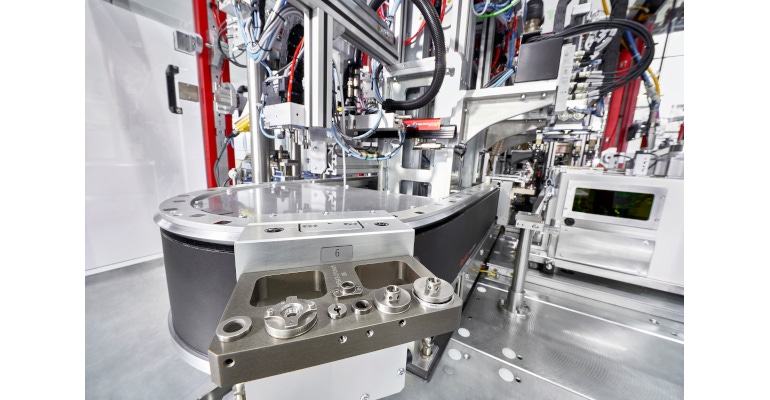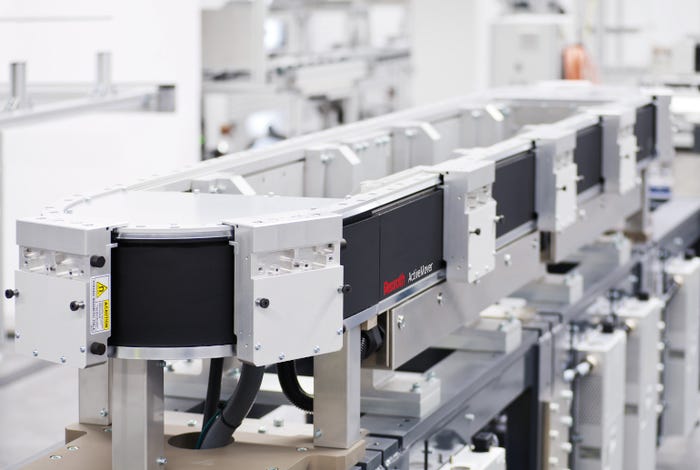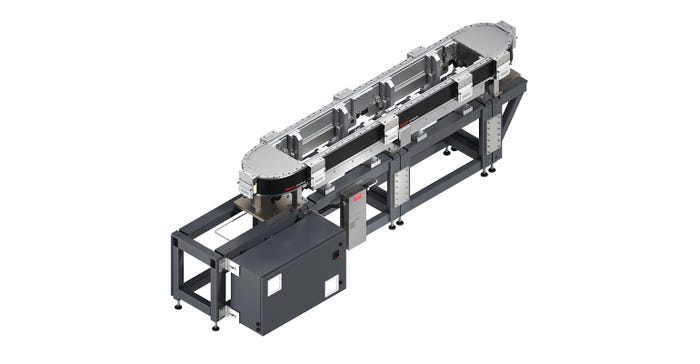Automated Conveying and Transport Systems Provide New Flexibility in Medical Device Manufacturing
Consider these 5 factors when evaluating the latest generation of smart conveyors for medical device manufacturing.

In medical device manufacturing, companies must leverage every opportunity they can to increase productivity and throughput, reduce costs, eliminate waste, and improve product quality and reliability—all while managing change on a daily basis. There are a number of production and assembly technologies available featuring new capabilities that can help medical device manufacturers achieve these goals. One of these is automated conveyor systems. Implementing an automated conveyor, especially in assembly or packaging operations, can increase manufacturing flexibility and productivity.
The newest generation of conveyors and transport systems incorporates features that can enable new levels of automation for medical device manufacturing. Choosing the right method of automatic transport and conveyance is often determined by the flow of materials, production volume, and product mix.
Medical Device Manufacturing Challenges
The products medical device manufacturers create are high-value, often quite sophisticated devices used by millions of people for vital short-term and long-term healthcare needs.
These products and their manufacturing processes tend to be highly regulated, requiring extensive documentation and rigorous quality control of their operations. In addition, medical product manufacturers face some of the most demanding operating conditions anywhere:
Short product runs and shrinking product life cycles
Complex products that require multistep, precision assembly
Small, sensitive components that must be handled delicately
Strict cleanliness and environmental controls
One of the ways medical device manufacturers, like other leading manufacturers, solve these challenges is by implementing effective lean manufacturing processes. Lean manufacturing provides a systematic way to identify waste and remove it.
Some medical device manufacturing or assembly processes work best using fully manual production processes, with little or no automated material transfer or conveying systems needed. These are products with low or uncertain production quantities, or where demand for different products is uncertain, so that the production mix has low predictability.
As the product mix becomes more predictable, with longer product runs to satisfy increased demand, automated production is the right choice when it helps medical device manufacturers increase process reliability and cut costs to recoup the investment in automated transport.
In the past, the use of conveyor systems in lean production environments was often rejected; it was thought that they were too inflexible and could potentially lock inefficient production processes in place, preventing effective lean efforts to eliminate waste.
Today’s flexible conveyor systems go far beyond that and are instrumental in minimizing waste in low-mix, medium-to-high-volume production commonly found in many medical device production applications. By combining speed with integrated parts tracking, precision workpiece holding, and ergonomically correct work positioning, well-implemented conveyor systems are a key piece in the lean factory.
Selecting the Right Type of Conveyor
Depending on the type of medical device being produced, there are a range of standard conveyor systems used in these operations. Conveyor systems can generally be categorized according to the type of conveying media they use. For medical device manufacturers, two of the most common systems used are twin-strand conveyors or plastic chain conveyors.
These systems can transport loads of 10 kilograms or more, which satisfies the requirements for a broad range of medical device and medical kit production operations. Typical transport speeds are 10 to 12 meters per minute and use diverters to offload products or components at workstations or assembly systems.
Most conveyors are powered by AC motors turning at a constant speed, moving in only one direction. Products are transported in totes or on pallets and are delivered to set points along the length of the conveyor through mechanical or pneumatic stops or diverters.
Tracking the products on the system often involves attaching RFID tags, either directly to the product being transported or to a tote, which sometimes contains multiple items, complicating tracking. This is a crucial concern for medical device manufacturers subject to regulatory requirements to track and document how every component in every device was handled, integrated, and tested throughout the production process.
These standard conveyors tend to “lock in” the speed and flow of manufacturing, with throughput determined by the upper limit of the conveyor. If new products require adding an assembly station or an extra machine into the production flow, modifying the conveyor layout can require downtime and engineering costs.
While for some operations this kind of transport is sufficient, some medical device manufacturers have more complex needs: they may need to move products through different assembly steps much faster, or they may need to vary the speed, and in some cases the direction of movement, to serve unique production requirements.

New Generation of Transport Systems
New material transport systems are now available that, to a certain extent, are redefining the capabilities and potential of conveyors. One of the most important advantages they offer is that they are engineered for greater flexibility, precision, speed, and process control—advantages that medical device manufacturers can use to increase productivity and facilitate more flexible production in response to constantly changing market demands.
These systems also support much faster throughput and more efficient use of costly manufacturing floor space, and they can more easily track material transport activities and communicate that data to plant management systems for documentation and analysis purposes.

When assessing which of the latest generation of smart conveyors to select, there are several factors medical device manufacturers should consider as they select the best solution for their needs:
Innovation. One innovative system replaces the typical belt or chain associated with standard conveyors entirely. Instead, it uses a revolving linear motor with vertically mounted workpiece pallets, with each workpiece pallet’s motion able to be individually defined—how fast it goes, where it stops—and even to reverse motion. This kind of flexible motion ensures that manufacturers gain the major benefits of automated transport without being locked into some of its drawbacks.
Speed. Linear motor-driven systems combine versatile motion with transport speeds up to 4 meters per second, significantly faster than many standard conveyors. In addition, some systems feature workpiece pallet changeover times under one second. And since each pallet is independently programmable, its position can be tracked and documented with 100% accuracy. Faster throughput and tight, pallet-level tracking can increase productivity, thereby helping reduce cycle time and manufacturing costs.
Precision. These new systems also offer a new level of endpoint precision with highly repeatable, individual stopping points of ± 0.01 millimeters. Stop positions can be configured in software anywhere around the system, even in curves. Many feature integrated measuring systems that enable for precise indexing of the pallets, eliminating the need for additional lift-and-locate units. This variable and flexible positioning of each workpiece pallet means device manufacturers can custom-configure the motion of each pallet to suit product-specific assembly requirements. The precise control provided by the linear motor also means there is virtually no loss of time for positioning the pallet in front of each workstation.
Robust design. These types of systems also pack a lot of functionality into tight footprints: some installations have replaced multiple conveyors with a single linear transport system and saved nearly 40% of the plant’s floor space. They feature a powerful drive with up to 160 newtons per pallet and incorporate both 180-degree and 90-degree curve modules to enable increased variation in transport system layouts. Also, transport systems like these usually support interfaces for many high-speed automation busses, such as ProfiNet and Ethernet IP, and EtherCAT. These interfaces allow easier integration with a device manufacturer’s existing machine communications backbone as well as connecting to edge-computing devices.
Technical support. One of the critical capabilities to assess when selecting conveyor transport systems is the technical support and simulation capabilities available for designing the system and programming its operations—even before the hardware comes into play.
Users should ensure the simulator allows creation of a “digital twin” of their machine. With one they could calculate power consumption, determine cycle time, the number of pallets and power units their system will need, and they could fully program the system, defining motion sequences, stop positions, move configurations, and many other system functions.
These kind of end-user simulation and configuration tools can make it much easier for medical device manufacturers to implement the latest technologies without going through steep learning curves.

As medical device manufacturers explore ways to make smarter use of automation to improve manufacturing productivity and flexibility, this new generation of material transport systems can become a valuable tool that is relatively easy to implement.
Manufacturers that have installed these types of transport systems have been able to dramatically improve productivity and reduce cycle time. The ability to independently program each pallet, varying its speed and direction, gives assemblers and manufacturers a powerful new tool to help them keep their production fast and lean as they respond to the needs of their markets and customers.
About the Author(s)
You May Also Like

.png?width=300&auto=webp&quality=80&disable=upscale)
